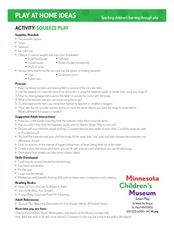National Gallery of Canada
Build a City of the Future!
Tap into your pupils' imagination by asking them to design futuristic, ideal cities. They must discuss and take scale and size into account, looking at some model pieces of art for inspiration and analysis. The final product for each...
Curated OER
Big and Small
Sorting big and small objects builds spacial reasoning classification, and visual discrimination skills. Your class will read a story about big and small bubbles, practice identifying big and small objects, then sort big and small balls...
Curated OER
Exploring Scale And Ratio
Learners measure the actual size and distance of the solar system using scale and ratio. They watch and discuss a video, create a distance-scale solar system model, and compare the scale sizes of planets to their actual sizes.
Curated OER
How Big Is a Blue?
Students sort and compare/contrast the lengths of various whales. They sort pictures of whales in order of smallest to largest, and given a rope marked with the lengths of the whales, they compare the actual lengths of the whales.
Curated OER
Nature Art
In this nature art instructional activity, learners take a nature walk and collect items with different sizes, textures and colors. Students use the items they collect to make a collage.
Curated OER
Squeeze Play
Young scientists demonstrate how to move objects. In this fine motor lesson, students use various objects such as dice, erasers, and soft balls and move them using the proper device.
Curated OER
Scaling Up Art
Students measure a sculpture of a human and measure other students. They determine the average size of humans and create a life size image of the sculpture. They work with percentages as they create the images.
Curated OER
Black Bat Silhouette
Students research the habitats, habits, shapes, colors, and sizes of bats. They recognize that silhouettes can be used in various forms of artwork. Students experiment with watercolors to see how easily these colors can be blended on wet...
Curated OER
Small
In this size worksheets, learners practice identifying items small in size. Worksheet is set up in 5 rows, 2 animals/items per row.
Curated OER
Matters of Milk and Marshmallows
Students observe a teacher demonstration o classifying matter by its physical properties of shape and size. After discussing the definition of matter, students describe the state of matter. They sing a song to the tune of "Bingo." In...
Curated OER
Backpacking - Lesson 2 - How to Fit a BackpackBackpacking - Lesson 2 - How to Fit a Backpack
Backpacking - Lesson 2 is part of an eight lesson unit on backpacking. This specific lesson is how to properly fit a backpack according to the length of a torso. Proper fit is important when carrying a load of substantial weight for...
Curated OER
Which Chocolate Is The Biggest?
Students investigate the concepts of area and perimeter with the use of chocolate bars. They calculate the perimeter and area of different size rectangle chocolate bars and record the statistics. Then students make a visual comparison...
Curated OER
Preschool Comparison Worksheet
Review the concept of size with preschoolers while practicing their direction following skills. Young learners are presented with four sets of images which they must compare to determine which is larger. They are then directed to cross...
Curated OER
Map Scale
Students investigate the purpose of map scale and how it is used to measure the distance and the size of objects.
Curated OER
Size and Shape
For this size worksheet, students color the shape in a row that is the same size as the first one in each row. Students then color that shape the same color as the first in the row.
Curated OER
Investigation So What's The Difference?
First graders investigate the differences between shapes. In this block characteristics lesson, 1st graders work in groups to explore blocks, group the blocks by different characteristics, discuss the block attributes and record...
Curated OER
Tallest: Size Worksheets
In this size comparison learning exercise, students must examine four different groups of pictures and determine which picture is the tallest in each group.
Curated OER
Sizes Worksheet: Smaller
In this size comparison worksheet, students will examine three shapes, determine the name of each shape and then draw a smaller version of each shape.
Curated OER
Sizes Worksheet: Smallest
For this size comparison worksheet, students will examine three groups of pictures and determine which picture in each group is the smallest.
Curated OER
Sizes Worksheet: Shortest
In this size comparison worksheet, students will examine two groups of items in columns to determine which item in each column is the shortest.
Curated OER
Size
In this size learning exercise, students put a list of sixteen words in connection with water, wind and accommodation in order of size, with the biggest or strongest at the top.
Curated OER
Seed Sensation
Students explore seeds through dissecting, sorting, comparing and contrasting. They draw their observations of both a closed and open seed and then they label the parts of a seed. They brainstorm where seeds come from. They compare seeds...
Curated OER
Stories from Africa
Students discuss the size of adult African elephants after a demonstration on their height. They try to guess the animal of discussion based on clues given about their size and characteristics. As a class, they try to identify other...
Curated OER
You Are Here
Students determine the relative size and distance of the planets in the solar system. They use ratios in their mathematical calculations to make models of the planets after discussing the relative sizes of the planets. They keep a...

























